What are the Formative Assessment Types? (Assessment FOR Learning!)
What is formative assessment vs summative, and which formative assessment types are the most effective? How do I progress monitor and track student data? Formative assessment is the number one way to align our instruction with what students need and it is so powerful.
Here are some formative assessment examples and definitions you can use to help tailor your instruction to YOUR students.
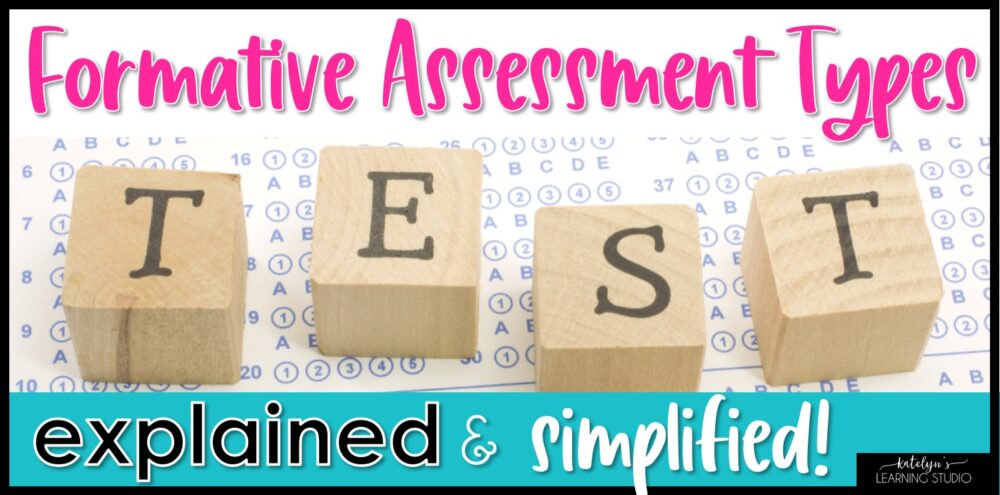
This formative assessment types list explains assessment FOR learning and easy ways to make the most of your formative assessments.
Formative assessments are like the secret sauce to teaching. You can have all of the immaculate, detailed lesson plans in the world–- but what really makes the difference is having a teacher that is responsive to the students. That is where the magic happens and instruction is effective because it is tailored to what the student actually needs.
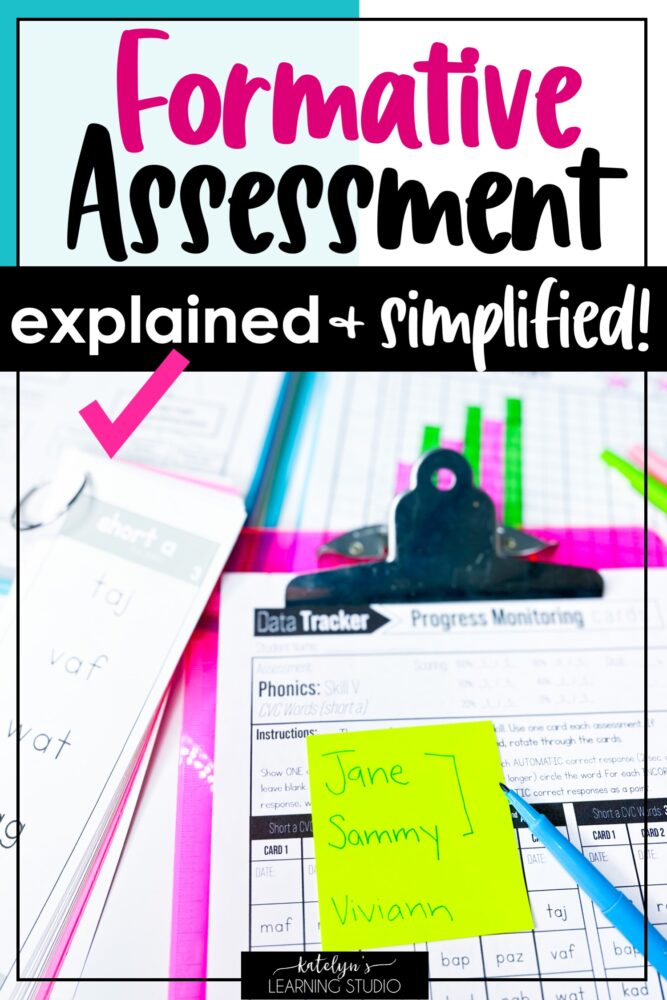
The formative assessment types that will make the biggest difference can still be simple!
Formative Assessment vs. Summative Assessment
There are 2 main types of assessment: formative assessment and summative assessment.
Assessment of Learning vs Assessment for Learning: What’s the Difference?
- Assessment OF learning (summative assessments):
- determines student achievement levels and helps place students in appropriate groupings and learning settings
- Assessment FOR learning (formative assessments):
- helps the teacher find out what the student needs and how to help them
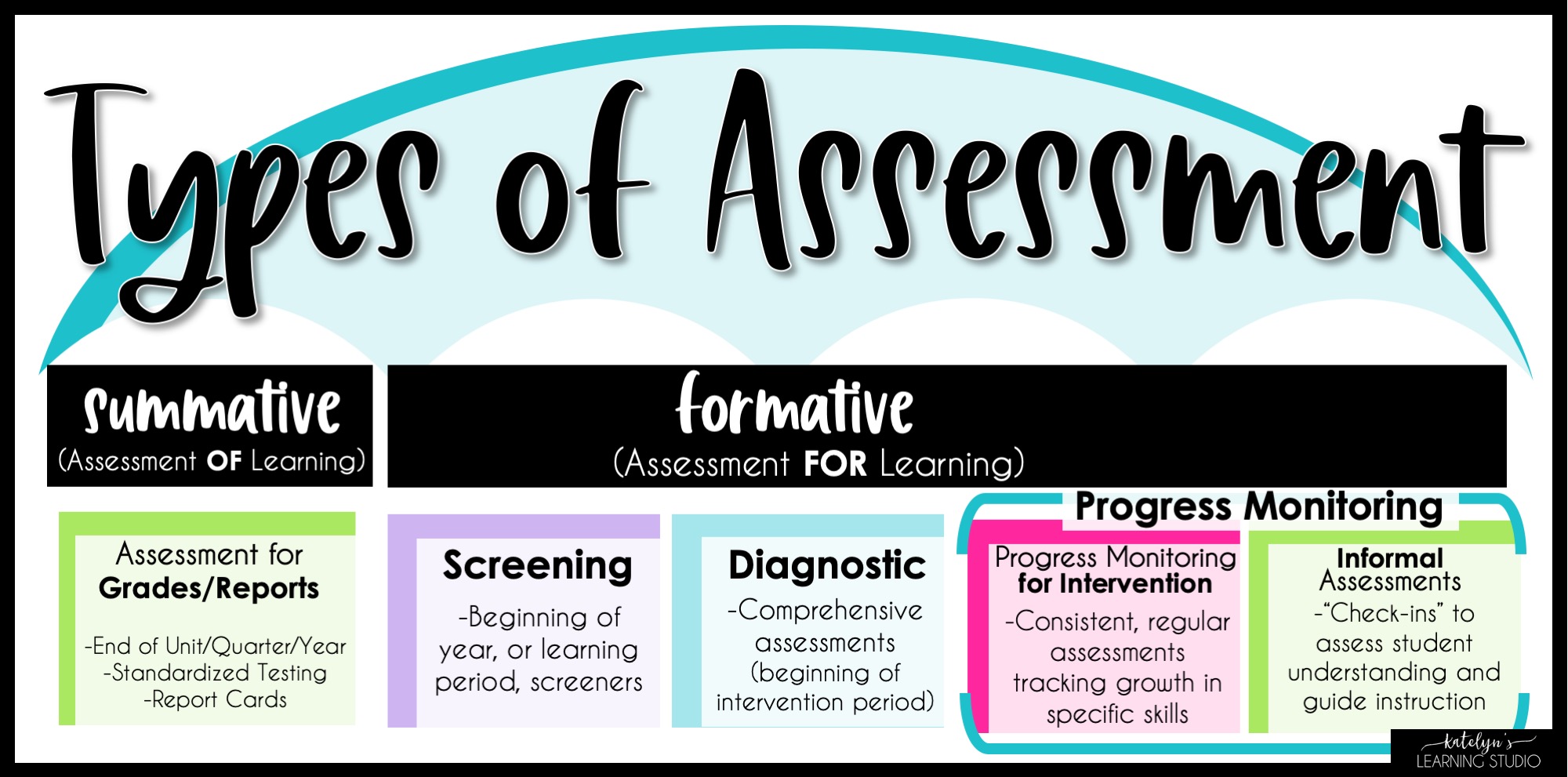
Formative assessment vs summative assessment: what’s the difference?
Summative Assessment
What is summative assessment?
- Summative Assessment definition: a test given to students at the END of a learning period to assess their level of achievement on a subject; scores are compared to a benchmark goal or set standard.
- Requirements for summative assessments:
- Be able to record results
- Be able to report results
- Be completely objective
- Summative Assessment Examples:
- End of Unit Tests
- Quarter Benchmark Tests (often district-wide)
- End-of-Year Benchmark Tests
- State Standardized Testing
- For older grades: assignments, homework, tests, and quizzes that accumulate to a student’s final score but do not change instructional strategies
Formative Assessment
What is formative assessment?
- Formative Assessment definition: a test given to students DURING the learning period to guide instruction so that it meets the student’s needs.
Think of assessment as one big category split into 2 groups: formative assessment and summative assessment.
THEN, think of “formative assessment” as split into 3 smaller groups.
These smaller groups are the 3 different formative assessment types.
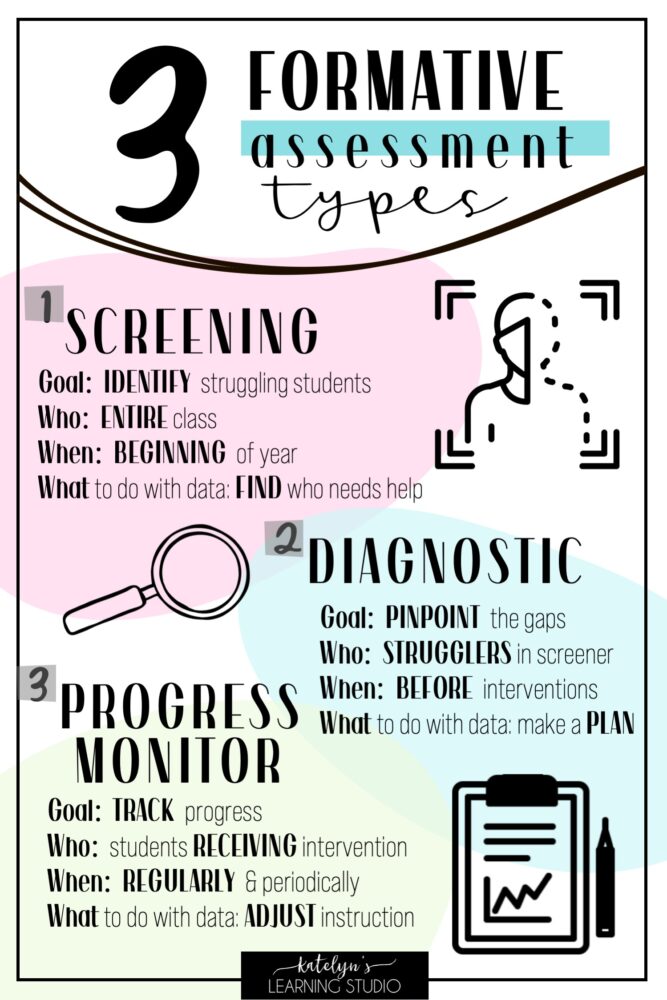
There are different formative assessment types that you can use to positively impact student success.
Formative Assessment Types
There are 3 types of formative assessment (plus an extra 4th one):
- Screening Assessments
- Diagnostic Assessments
- Progress Monitoring Assessments
- Informal Assessments (which are really a sub-type of progress monitoring)
Which formative assessment type you use depends on what your goal is and who you need to assess.
I pulled the graphic above from my Teacher’s Guide for How to Assess Reading post. It has a lot of information on how to assess each of the Big 5 Areas of Reading.
1. Screening Assessments:
Goal: Identify any students who are struggling
Who: Assess the entire class
When: At the beginning of a learning period
What to do with data: Find students who are below-level and provide interventions
2. Diagnostic Assessments:
Goal: Figure out WHERE specifically struggling students have gaps and need intervention
Who: Students you identified in the screener assessment
When: After the screener but before interventions are given
What to do with data: Make a personalized student plan to address any gaps you found
3. Progress Monitoring:
Goal: Track student progress on a specific skill
Who: Students who are receiving intervention
When: Regularly and periodically throughout a learning period
What to do with data: Analyze it to see how you need to adjust instruction (I have a post coming soon about analyzing data!)
4. Informal Assessments: (a sub-type of progress monitoring)
Goal: Quickly check student understanding
Who: Whole class or individual students
When: Usually during or right after a lesson
What to do with data: (not always formally recorded)
- use post-lesson data to determine if students understood a lesson
- record anecdotal notes to give a well-rounded picture of student understanding
- use mid-lesson checks to guide lesson pace
For screening and diagnostic assessments, I use this Comprehensive Reading Assessment. For progress monitoring, I use this easy Progress Monitoring flip-card system. I’ll dive into informal assessments below!
Data tracking for formative assessments can give you valuable information when used strategically, like in the tracking sheets that come with these Reading Intervention Binders.
When do I collect data from formative assessments?
Formative assessments are used in different ways.
- Sometimes they are informal and are just used to quickly guide your instruction and get a feel for student understanding.
- Sometimes they will be to identify specific student needs, track progress, and make strategic decisions in your lesson planning and intervention.
Record data for situation #2.
Do not stress about recording data for everything. Because honestly, not all data is equal. And too much data can lead to overwhelm and it’s too hard to glean anything from it then.
In my opinion, if you record every single worksheet/activity/response students do, you will spend all of your time entering numbers and the quality of the data will not always be great anyways.
Instead, collect data several times throughout a learning period using a high-quality, targeted assessment. This will make it easier to ensure the results are reliable and accurate, and lets you zero in on a specific skill. Then analyze THAT data. I’ll have more on how to analyze data soon!
These Reading Intervention Binders make data collection super easy. Each activity in the binder has a matching datasheet you can use to track student progress on reading skills!
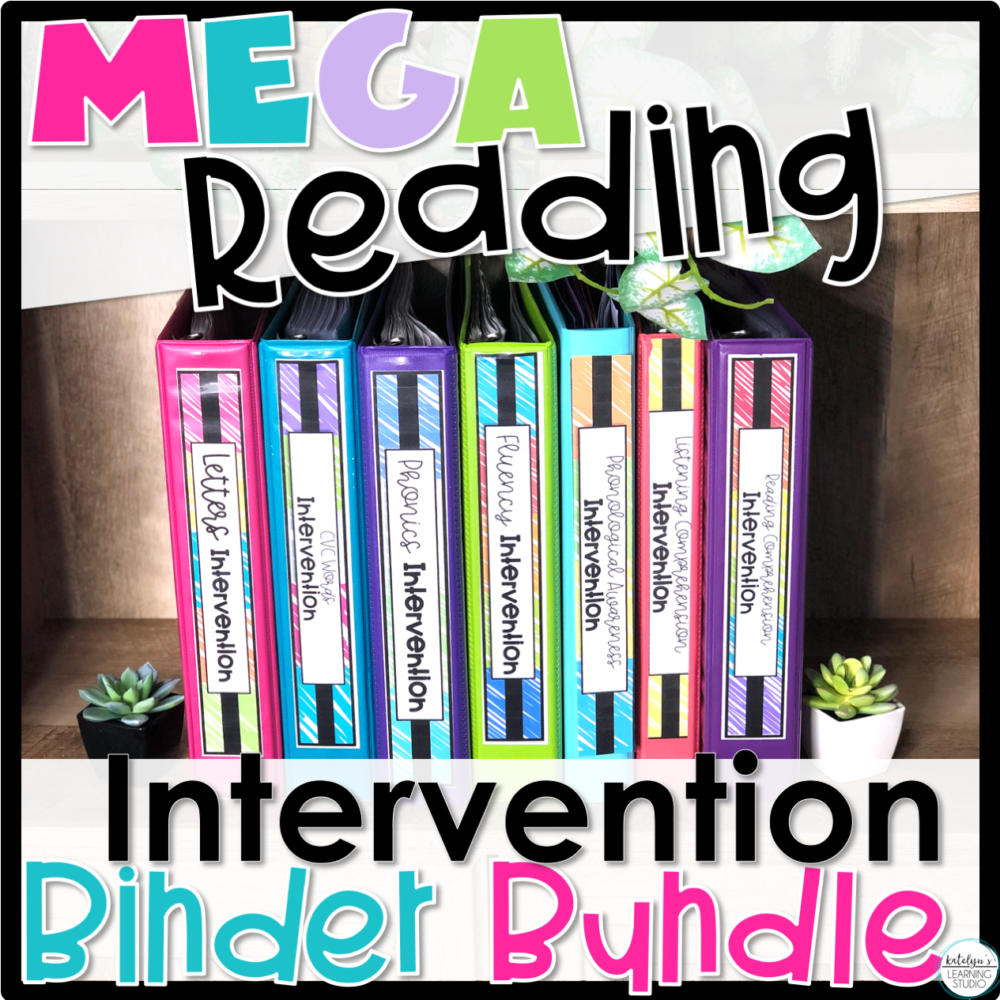
These Reading Intervention Binders help you intervene AND track progress at the same time!

These formative assessment strategies will make your note-taking so much easier! Plus here are a couple of FREE editable note-taking tools (you need to have PowerPoint to download them)!
EASY Formative Note-Taking Strategies:
Note-taking is an important part of making your formative assessments useful, but it’s really hard to complete quickly and keep it organized.
Here are a few easy ways to keep your notes convenient and organized.
Taking notes while walking around the classroom:
- Have a paper with a grid of squares on it (see the free download below). Have each student’s name at the top of a square. Jot notes down in that student’s square as you observe.
- OR, carry around a sticky notepad and write down notes for a student on the top sticky note. Then fold it up and write on a new sticky note for each student. Then after the lesson transfer the notes to a more permanent place like a data binder or spreadsheet.
Taking Notes during the middle of a lesson:
- Have a class roster (see the free download below) printed out and easily accessible WHILE you are teaching. If you notice someone struggling during the middle of instruction, quickly (& discretely) circle/underline/star their name.
- You could also have a notepad easily accessible to write the names of students you want to follow up with when they move on to independent work.
CLICK HERE to download some FREE Editable Note-Taking Tools you can use with these strategies! (note: you will need to have PowerPoint to be able to access and download them)
What do you take notes on?
- Skills the student struggles with
- Consistent mistakes they make
- Specific words or phonics patterns they need more practice on
- Concepts the student is confused on
- Cues you give that you notice work for that student
- Strengths and positive praise you notice about them!! (especially great to share at parent-teacher conferences)
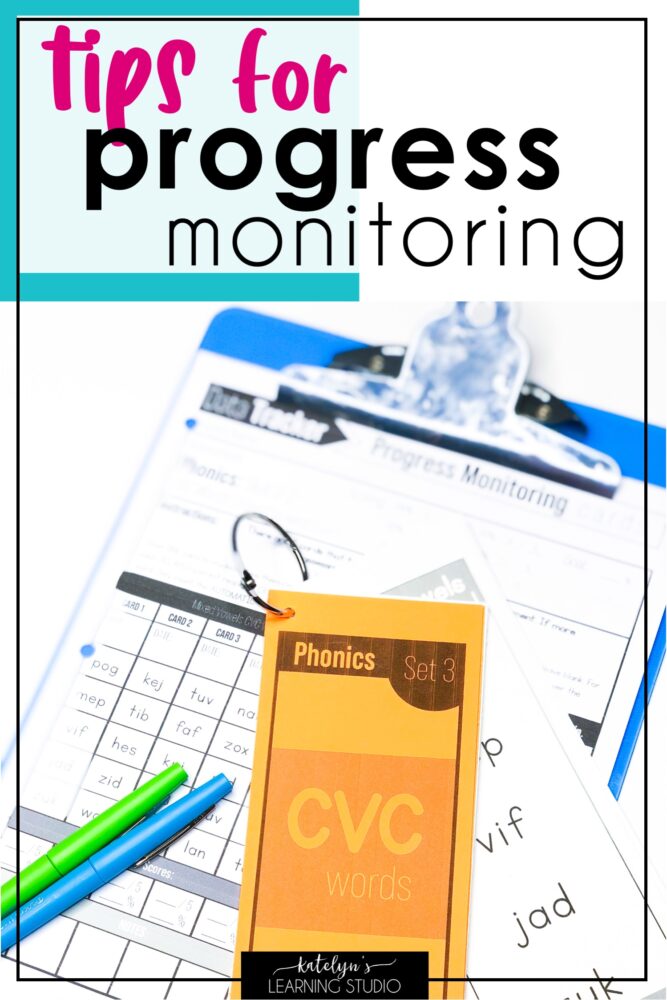
Progress monitoring can be overwhelming, but using a consistent format like these progress monitoring cards can help keep it simple and effective.
Progress Monitoring for Intervention
When Progress monitoring is used to inform intervention, it needs to be more strategic and organized. It’s important to track the student’s response to intervention so you know if your intervention is working. You also need to show evidence of progress by providing data at IEPs and parent-teacher conferences. Organized and specific data is the perfect way to do that!
How do you Progress Monitor?
- Choose one skill the student needs to build (identified from a diagnostic assessment).
- Create a SIMPLE assessment you can give them every 1-3 weeks.
- Keep the assessment the same, just switch out the words/letters/questions.
- Record the scores for each administration and track progress or regression.
FREE Tools for Progress Monitoring:
Here is a simple free progress monitoring form you can use to easily track student progress in any skill, and a motivating free fluency progress tracker that students love to fill out themselves to track their reading fluency!
Formal Progress Monitoring Tips
When you’re trying to balance a bazillion other things on top of regular and consistent progress monitoring, life can get super stressful. The pressure to do it consistently and to measure the right skill is hard. Here are a few tips to make it easier.
Tips for Easier Progress Monitoring:
1. Make it quick!
- It only has to be a few questions, not an entire test. Depending on the skill, it can just be 5 or so quick questions–- I like 5 because it gives easy 20% intervals for scoring.
2. Make it simple.
- For phonics, it can just be reading 5 words.
- For phonemic awareness, it can just be doing the skill for 5 words.
- For fluency, just read a paragraph.
- Comprehension and vocabulary take a little more planning as they need pre-written and thought-out questions, but they can be with quick sentences/sentence sequences instead of entire passages.
3. Make it targeted.
- Just choose ONE skill to assess. For effective progress monitoring, you really need to zero in on just one skill so you can clearly determine if the student has that specific skill mastered.
4. Make it aligned.
- For that one skill you are assessing, make sure your test actually assesses that skill in exactly the way your objective states students will show mastery.
5. Make it consistent.
- Use the same scale/measure for each administration. That way you can see accurate trends quickly at a glance.
6. Make it recorded.
- It is important to take data for formal progress monitoring. This is where your proof of progress is. It doesn’t have to be fancy.
- It can just be a page for each student with several blank 2-row tables on it.
- Write the date across the top and the score underneath.
- When you move onto a new skill, start using a new table.
- Be sure to label each table so you know what skill it goes with and what assessment you used!
- OR, just download this FREE Progress Monitoring Form to record your data!
7. Make it easy.
- Create a system that you stick to.
- I put assessment cards on a binder ring for each topic.
- They range from easy skills to hard skills and there are several cards for each skill (with different words switched in).
- To give the assessment, I just pull out the set I need and flip to the card the student is on.
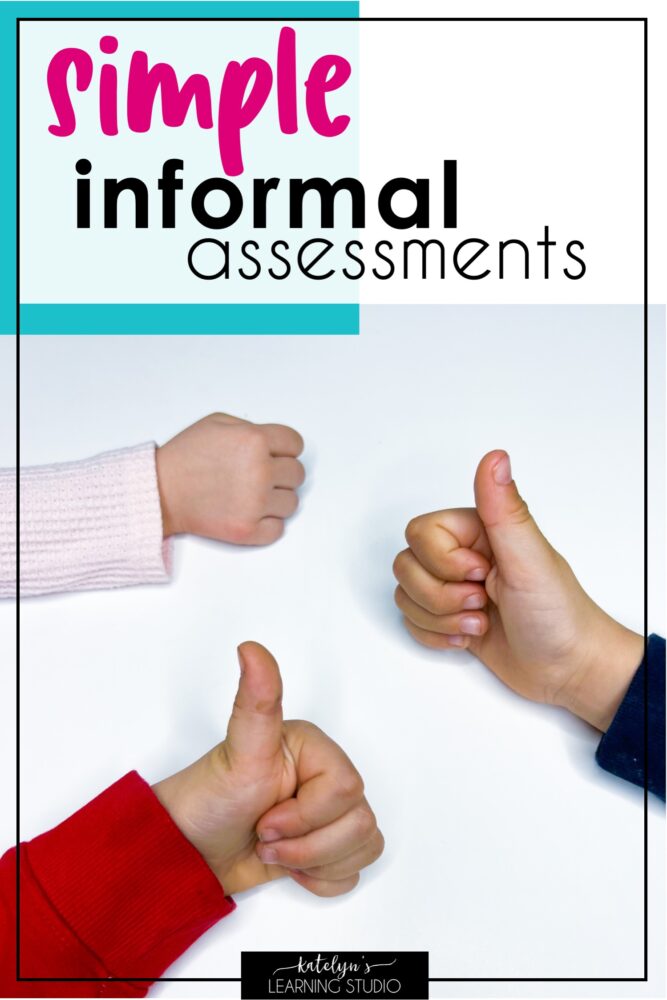
Informal assessment can have so many variations, and can often be quick and easy.
Informal Assessments (it doesn’t have to be complicated)
Formative assessment does not have to be intimidating and overwhelming. It can be very simple, and you are most likely already doing it. Informal assessments in particular are very natural and easy to weave into your instruction.
To make the most of your informal assessments, let them INFORM your teaching.
- Use them as a gauge to spend more time, move on, or switch gears during a lesson.
- Use them to quickly identify students who are struggling with the lesson.
- Use them as a way to help students be accountable and engaged in their learning.
Your traditional “check for understanding” assessments you give during normal classroom lessons are perfect examples of informal assessments. They are for the teacher to use to guide instruction and monitor the entire class. They don’t have to be turned in to anyone and there is often no standardized way to give them (although some teams and schools might align their informal assessments).
Informal Formative Assessment Strategies
Here are some strategies you can use to quickly assess and gather informal data:
- Observing engagement and participation in practice questions and activities
- Walking around and recording observations as students work
- Talking/listening to students
- Collecting and checking student work
*See the next 2 sections for specific ideas of informal assessments!

Formative assessments can be given at multiple points throughout the day.
WHEN to Give Formative Assessments
Here are some formative assessment examples you might use at different points in learning.
DURING a lesson:
- Students self-check after a practice question and signal if they got it correct
- Students show their responses to practice questions
- Students give a signal for whether they understand or not (thumbs up or down under their chin)
- Students discuss with a partner (the teacher walks around and listens)
- Teacher walks around while students do a practice question and observes student work
AFTER a lesson:
- Worksheets or activities the teacher collects and checks
- Conversations with the teacher
- Walk around while students are working and observe/take notes
- Self-check routines (students grade their own work)
Formal Progress Monitoring:
- Strategic and regular assessments are given to track student progress on a particular skill
- Intentional, regular, and scheduled time is set aside to take these quick assessments
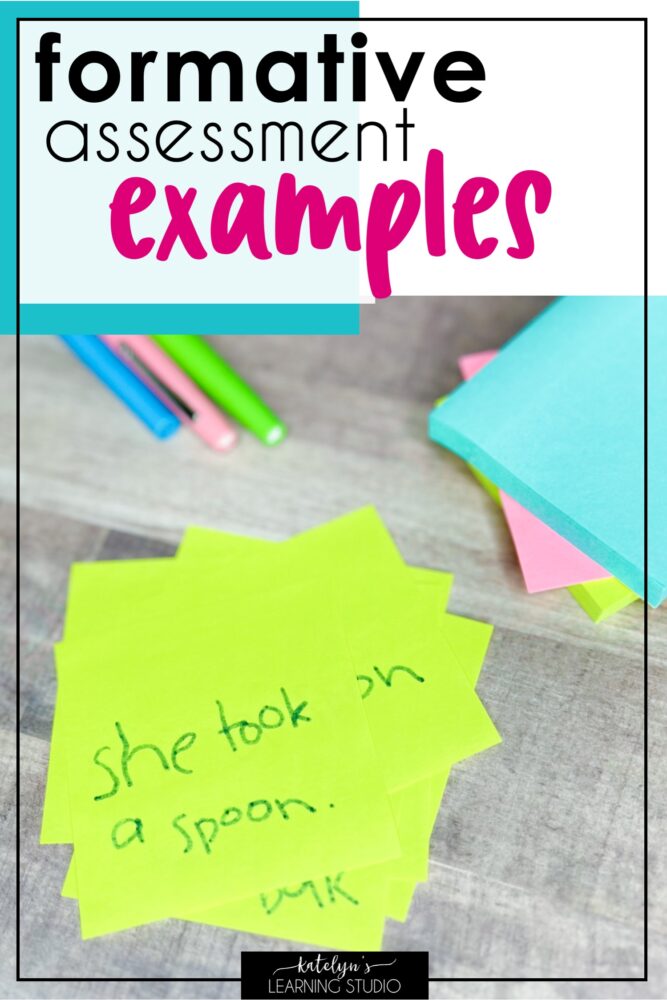
Formative assessment examples can include self-assessment signals, written answers, verbal discussion, or observation.
Formative Assessment Examples: EASY Assessments
Real life is busy and chaotic, and sometimes you just need an easy way to monitor progress! These are all examples of practical and easy informal formative assessments that can help you quickly get a gauge and feel for how the class is doing as a whole, and keep an eye on students who might be struggling in that topic.
Formative Assessment Examples:
- Students show a thumbs up or thumbs down under their chin during a lesson (to answer a yes/no question or to self-assess if they understand or not).
- Students write answers on whiteboards and show the teacher their answer.
- Think, Pair Share
- Students just think the answer in their head, then on the teacher’s signal they turn to a neighbor and tell each other what they think the answer is and why.
- Whisper in hand, say it out loud
- Have students whisper the answer into their hand, then “hold it”, and on the count of 3 say it out loud.
- Students can show the answer on their fingers (counting sounds/syllables in words, assigning each answer choice a number, etc.).
- Colored response cards
- Students have a red, yellow, and green card. They can hold up the color that corresponds with the answer, or use it to self-assess if they understand or not.
- OR, they can have the cards in a pile at their desk and have the top color show how well they are understanding.
- Have students give themselves a self-assessment score (1-3, yes/no, etc.) on a sticky note, write their name on the back, and stick it on the board.
- Exit tickets
- On a small piece of paper have students answer one question and hand it to the teacher before they walk out the door.
- OR for accurate verbal assessments for reading (like explained in this post on the best assessments for reading), have them read a few words you point to before they walk out the door (like in the exit tickets pictured in the section above this one).
- Students answer a question on a sticky note, write their name on the back, and stick it in a pile on the teacher’s desk (or have their name on top and the answer on the bottom for more anonymity).
These are all ideas for assessments that will guide your instruction, but not necessarily monitor individual student progress. For that, you will want to use a more formal progress monitoring system like these progress monitoring flip cards.
FREE Reading Intervention Cheat Sheet
With all of this said, formative assessment is only valuable if you are using it ALONGSIDE quality reading intervention. For some quick tips on how to identify student needs and some research-based and targeted reading activities, download this FREE Reading Intervention Cheat Sheet!
You can also check out my Ultimate List of Reading Intervention Activities for tons of hands-on and engaging activities to do with your students.
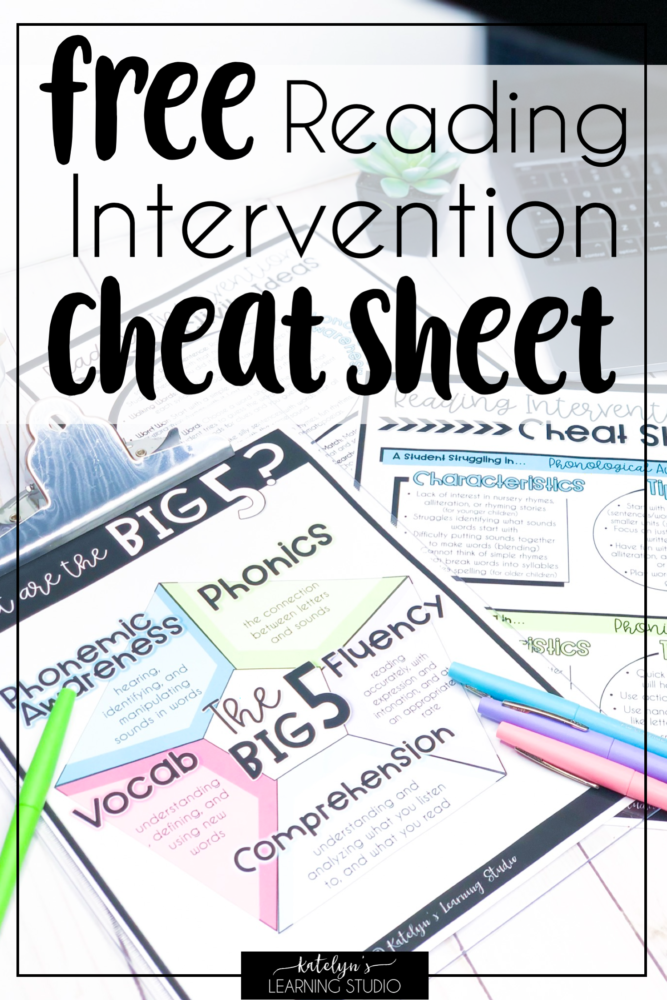
These reading intervention strategies and ideas will help your struggling readers! Click here to download it for free!
Hopefully, these formative assessment examples helped you understand all of the different types of formative assessment and see the value in using formative assessment vs summative. Progress monitoring and informal assessments help you keep a gauge on student learning and adjust your teaching so you are meeting your students’ needs. And they don’t have to be overwhelming! Real-life formative assessments can be quick and simple while still being powerful.
